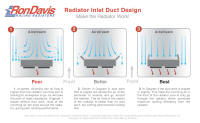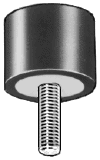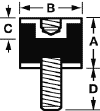
Instructions and Technical Information
Installation, Mounting, and Maintenance Instructions
Testing
for electrolysis in cooling systems
Spal Fan Wiring Instructions
Spal Fan Three Relay
For A/C Diagram
Remote Fill Plumbing
Diagram
Radiator cap not sealing?
Radiator Inlet Duct Design

GM saddle mount rubbers must
be trimmed to fit radiator
Vibration insulators shown below can be
purchased from Ron Davis Racing Products.


|
Testing
for electrolysis in cooling systems
A voltmeter capable of reading both AC and DC currents is required to test
cooling systems. The meter needs to read zero to the maximum voltage of
the system being tested in tenths of a volt. The meter leads must be
long enough to reach between the coolant and the groundside of the
battery. An ohm function of a voltmeter is very helpful to pinpoint
areas of resistance in as electrical system that will cause an
electrical current to ground through the coolant rather than the
engineered electrical circuit.
Procedure
-
Attach the proper meter lead to the
groundside of the battery, negative-to-negative or positive-to-positive.
-
Install the second lead in the
coolant touching the coolant only.
-
Read the DC and AC voltage with all
systems off. If a block heater is present, also take a reading with the
heater turned on. If an automatic battery charger is present, as a
standby system, also take a reading with this system running.
-
Read the DC and AC voltage with the
electrical starter engaged.
-
Read the DC and the AC voltage with
the engine running and all systems turned on: lights, coolers, fans,
heaters, air conditioning, cell phone, two-way radio, including the
phone and radio on both standby and transmit.
-
The above procedure will test a
complete system except for an electrical current, which can be generated
by the rear end transmission. This is particularly true with air bag
suspensions, rubber pad suspensions and rubber-mounted transmissions.
Any current generated will travel up to the drive shaft to ground
through the engine coolant. Grounding rear ends and transmissions is
strongly recommended.
-
Voltage of zero to .3 is normal in a
coolant of cast iron engine. Such an engine will be destroyed with time
by .5 volts, and engine manufactures are reporting .15 volts will
destroy an aluminum engine.
-
The current will be AC if the problem
is due to static electricity.
-
If the coolant shows an electrical
problem with all the equipment turned on; turn off one system at a time
until you finally turn off the system that stops the electrical current.
When the current stops, this will indicate the electrical system causing
the problem.
-
Be partially careful of starters.
They can cause as much damage to a cooling system as a direct connection
to an arc welder. This is due to the amperage present.
-
Always change the coolant if a
current is detected. The electrical current will destroy the protecting
chemicals in a properly inhibited coolant.
The following
are failures that are not manufacturer defects and therefore not covered
under warranty.
-
Improper Flush -
Cooling systems require a through flush of the radiator, engine,
overflow tank, hoses and heater core, failure to do so will lead to
mixing coolants and contaminates and creating a deadly cocktail for the
cooling system.
-
-
Corrosion – The
correct coolant and distilled water mixture prescribed by the
coolant manufacture of choice must be maintained. Water with high trace
elements of minerals will create problems for aluminum radiators not
normally seen in copper radiators.
-
-
Electrolysis
– Electrolysis is the systematic removal of the protective layer on the
inside of the radiator tubes due to improper grounding. Electrical
grounding problems can stem from poor installation of aftermarket
accessories or incorrect vehicle collision damages.
|
|
Questions Call
1-800-842-5166 |
|
|
|
Duplication
of this website in whole or in part is expressly forbidden
without prior
written permission from Ron Davis Racing Products, Inc
Copyright 2011 Ron Davis Racing Products, Inc. All rights reserved.
|
Aluminum radiators, aluminum radiator, auto
radiator, aluminum race car radiator, auto radiator, aluminum racing radiator,
custom radiator , aluminum jeep radiator, aluminum viper radiator, aluminum
mustang radiator, aluminum corvette radiator, aluminum sand car radiator ,
aluminum radiator , aluminum sprint car radiators, aluminum radiators,
aluminum car radiator , corvette aluminum radiators, aluminum race car
radiators, aluminum jeep radiators, aluminum viper radiator, custom aluminum
radiators, custom aluminum radiator, car radiator, corvette radiator, C6


